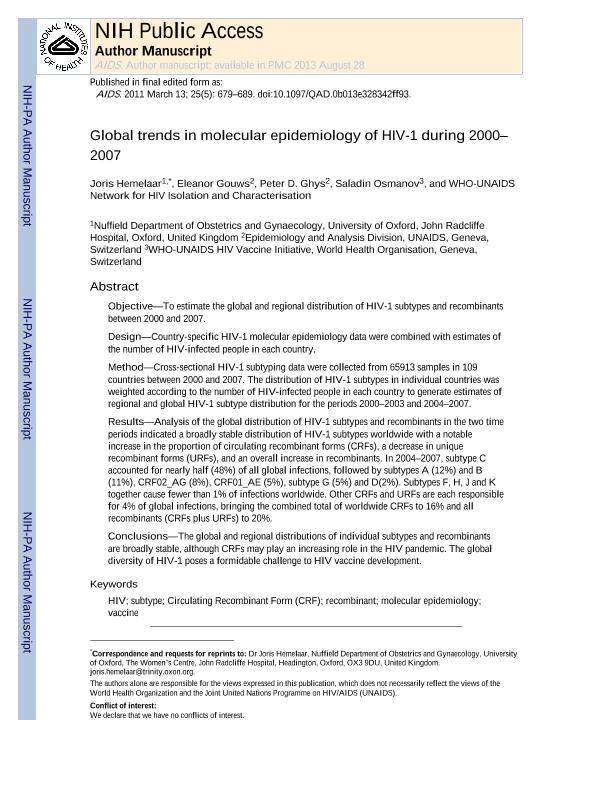Mostrar el registro sencillo del ítem
dc.contributor.author
Hemelaar, Joris
dc.contributor.author
Gouwsb, Eleanor
dc.contributor.author
Ghysb, Peter D.
dc.contributor.author
Osmanov, Saladin
dc.contributor.author
WHO-UNAIDS Network for HIV Isolation and Characterisation
dc.contributor.author
Salomon, Horacio Eduardo

dc.date.available
2017-02-20T21:00:12Z
dc.date.issued
2011-03
dc.identifier.citation
Hemelaar, Joris; Gouwsb, Eleanor; Ghysb, Peter D.; Osmanov, Saladin; WHO-UNAIDS Network for HIV Isolation and Characterisation; et al.; Global trends in molecular epidemiology of HIV-1 during 2000-2007; Lippincott Williams; Aids; 25; 5; 3-2011; 679-689
dc.identifier.issn
0269-9370
dc.identifier.uri
http://hdl.handle.net/11336/13189
dc.description.abstract
Objective
To estimate the global and regional distribution of HIV-1 subtypes and recombinants between 2000 and 2007.
Design
Country-specific HIV-1 molecular epidemiology data were combined with estimates of the number of HIV-infected people in each country.
Method
Cross-sectional HIV-1 subtyping data were collected from 65913 samples in 109 countries between 2000 and 2007. The distribution of HIV-1 subtypes in individual countries was weighted according to the number of HIV-infected people in each country to generate estimates of regional and global HIV-1 subtype distribution for the periods 2000–2003 and 2004–2007.
Results
Analysis of the global distribution of HIV-1 subtypes and recombinants in the two time periods indicated a broadly stable distribution of HIV-1 subtypes worldwide with a notable increase in the proportion of circulating recombinant forms (CRFs), a decrease in unique recombinant forms (URFs), and an overall increase in recombinants. In 2004–2007, subtype C accounted for nearly half (48%) of all global infections, followed by subtypes A (12%) and B (11%), CRF02_AG (8%), CRF01_AE (5%), subtype G (5%) and D(2%). Subtypes F, H, J and K together cause fewer than 1% of infections worldwide. Other CRFs and URFs are each responsible for 4% of global infections, bringing the combined total of worldwide CRFs to 16% and all recombinants (CRFs plus URFs) to 20%.
Conclusions
The global and regional distributions of individual subtypes and recombinants are broadly stable, although CRFs may play an increasing role in the HIV pandemic. The global diversity of HIV-1 poses a formidable challenge to HIV vaccine development.
dc.format
application/pdf
dc.language.iso
eng
dc.publisher
Lippincott Williams

dc.rights
info:eu-repo/semantics/openAccess
dc.rights.uri
https://creativecommons.org/licenses/by-nc-sa/2.5/ar/
dc.subject
Circulating Recombinant Form
dc.subject
Hiv
dc.subject
Molecular Epidemiology
dc.subject
Recombinant
dc.subject
Subtype
dc.subject
Vaccine
dc.subject.classification
Epidemiología

dc.subject.classification
Ciencias de la Salud

dc.subject.classification
CIENCIAS MÉDICAS Y DE LA SALUD

dc.title
Global trends in molecular epidemiology of HIV-1 during 2000-2007
dc.type
info:eu-repo/semantics/article
dc.type
info:ar-repo/semantics/artículo
dc.type
info:eu-repo/semantics/publishedVersion
dc.date.updated
2017-02-15T14:08:38Z
dc.journal.volume
25
dc.journal.number
5
dc.journal.pagination
679-689
dc.journal.pais
Estados Unidos

dc.description.fil
Fil: Hemelaar, Joris. University of Oxford; Reino Unido
dc.description.fil
Fil: Gouwsb, Eleanor. UNAIDS; Suiza
dc.description.fil
Fil: Ghysb, Peter D.. UNAIDS; Suiza
dc.description.fil
Fil: Osmanov, Saladin. WHO-UNAIDS HIV Vaccine Initiative; Suiza
dc.description.fil
Fil: WHO-UNAIDS Network for HIV Isolation and Characterisation.
dc.description.fil
Fil: Salomon, Horacio Eduardo. Consejo Nacional de Investigaciones Científicas y Técnicas. Oficina de Coordinación Administrativa Houssay; Argentina
dc.journal.title
Aids

dc.relation.alternativeid
info:eu-repo/semantics/altIdentifier/url/http://journals.lww.com/aidsonline/pages/articleviewer.aspx?year=2011&issue=03130&article=00018&type=abstract
dc.relation.alternativeid
info:eu-repo/semantics/altIdentifier/doi/http://dx.doi.org/10.1097/QAD.0b013e328342ff93
dc.relation.alternativeid
info:eu-repo/semantics/altIdentifier/url/https://www.ncbi.nlm.nih.gov/pmc/articles/PMC3755761/
Archivos asociados
